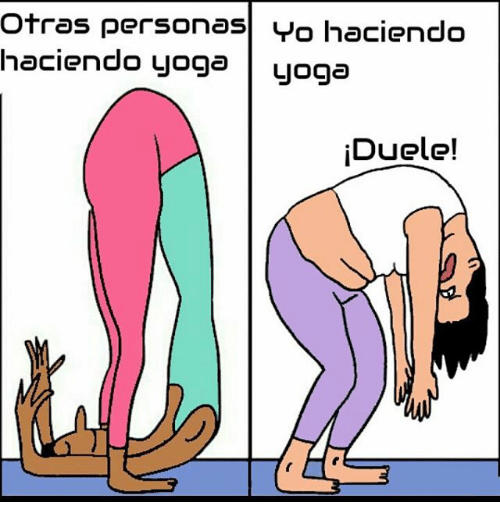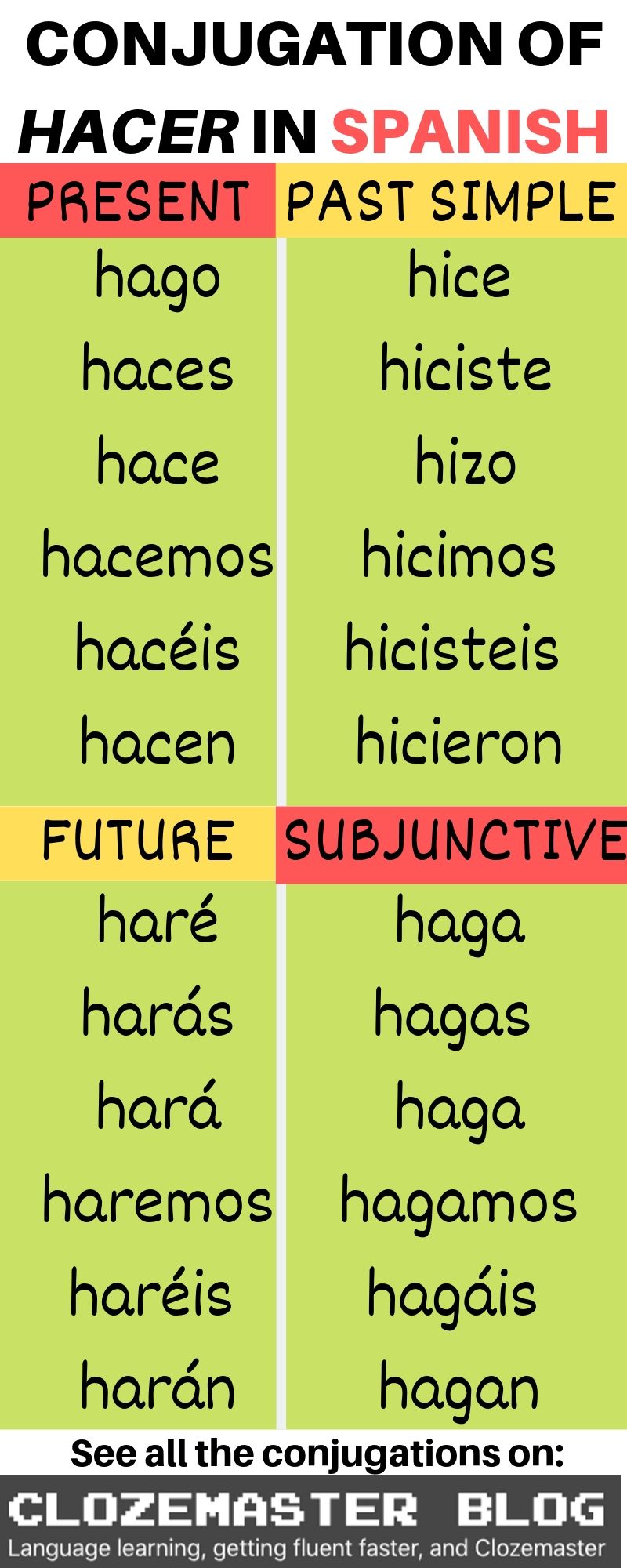
You might have seen a meme going around that compares “do”, “did”, and “done” in English to Spanish’s seemingly endless number of different forms of their equivalent verb: hacer. At first glance, this can seem extremely daunting and make Spanish seem like the hardest language ever! But don’t let this scare you off. Everything in Spanish has a pattern. Once you understand the hacer conjugation, it all makes perfect sense.
Hacer is an interesting word because it incorporates both the English “make” and “do”, which makes it one of the most used verbs in the Spanish language. And the good news is that as far as Spanish irregular verbs go, this is actually one of the tamer ones.
Note: If you’re not sure about any of the conjugations and what they mean, we’ve recently posted an in-depth explainer of all the Spanish tenses. Check that out if you need any further guidance with the topics of this post!
Verbals of hacer
Let’s start with looking at the few ways we can use hacer without it being in a conjugated form in a sentence. Verbals are the un-conjugated forms of the verb. They need to go with another verb which is conjugated in order to be used in a sentence.
Infinitive: hacer (to do)
Example: Mi marido no está motivado a hacer ejercicio. | My husband is not motivated to do exercise.
Gerund: haciendo (doing)
Example: Julio se está haciendo el enemigo de todos. | Julio is becoming everyone’s enemy.
See more on how to use the gerund in our estar conjugation guide.
Participle: hecho (done)
Example: No he hecho nada malo pero aún así le caigo mal a mi profesor. | I haven’t done anything wrong but my teacher still doesn’t like me.
For an explanation on this structure, see our article on how to use haber.

Hacer conjugation: basic forms
The most common hacer conjugation forms are as follows:
| Subject | Present | Preterite | Future | Imperfect |
| yo | hago | hice | haré | hacía |
| tú | haces | hiciste | harás | hacías |
| él, ella, Usted | hace | hizo | hará | hacía |
| nosotros | hacemos | hizimos | haremos | hacíamos |
| vosotros | hacéis | hicisteis | haréis | hacíais |
| ellos, ellas, ustedes | hacen | hicieron | harán | hacían |
Examples of hacer conjugation in present tense
- Hago mis deberes no porque quiero sino porque necesito. | I do my homework not because I want to but because I have to.
- Me haces sonreír con la manera que me hablas. | You make me smile with the way you talk.
- Mis padres hacen paella cada domingo. | My parents make paella every Sunday.
The present tense is not so hard to remember: almost a regularly conjugated -er ending verb, with the exception of the first person conjugation.
Examples of hacer conjugation in past preterite tense
- Hice mi propio desayuno ayer. | I made my own breakfast yesterday.
- Mi novio me hizo una flor de papel. | My boyfriend made me a paper flower.
- Hicimos lo que pensábamos que iba a ser lo correcto. | We did what we thought was right.
Examples of hacer conjugation in future tense
- Haré lo que sea necesario para no perder a mi hijo. | I’ll do whatever is necessary in order not to lose my son.
- ¿Haréis la presentación hoy? | Will you do the presentation today?
- Sus nietos me harán caso a mí? | Will your grandchildren pay any attention to me?
Note that even the future form of hacer is irregular. While the future tense is usually formed simply by adding the endings to the infinitive form, the future hacer conjugation is formed by taking out the ce from the middle of the word, and then adding those endings.
What have you noticed so far about sentences using the verb hacer?
This is a transitive verb, which means that it is always followed by a direct object, unless that object is implied. Hacer can also be ditransitive, meaning it can take both a direct and indirect object. The indirect object is usually in the form of an indirect pronoun.
Examples of hacer conjugation in past imperfect tense
- Yo hacía tareas de casa por 8 horas cada día durante 10 años. | I did housework for 8 hours a day for 10 years.
- Los colores de la foto la hacía verdaderamente bonita. | The colours of the photo made it truly beautiful.
- Hacíamos todo lo que podíamos para dejar de fumar. | We did everything we could to quit smoking.
If you’ve already studied up on the regular conjugations in Spanish, you might notice that there is nothing strange about this conjugation at all. In fact, the past imperfect is the only hacer conjugation that is completely regular.
Note: You might have noticed that hacía can mean both “I did” and “he/she/it did”. If the context is at all ambiguous, make sure you include a subject in your sentence. It’s good practice to put it in anyway, while you’re learning, just to be sure there is no confusion!

Hacer conjugation: Advanced forms
If you’ve mastered that first lot and are ready for something a bit more challenging, here are the subjunctive and conditional forms of the hacer conjugation in Spanish.
| Subject | Present Subjunctive (that you) have | Imperfect Subjunctive (if I) had… |
Conditional (I) would have |
| yo | haga | hiciera | haría |
| tú | hagas | hicieras | harías |
| él, ella, Usted | haga | hiciera | haría |
| nosotros | hagamos | hiciéramos | haríamos |
| vosotros | vayáis | hicieráis | haríáis |
| ellos, ellas, ustedes | vayan | hicieran | harían |
Examples of hacer conjugation in present subjunctive
- Cuando haga lo que prometió, tal vez lo perdono. | When he does what he promised, I might forgive him.
- Haga lo que haga mi hermano, yo siempre lo amaré igual. | Whatever my brother does, I’ll always love him the same.
- La profesora no permite que ellos hagan ruido. | The teacher won’t let them make noise.
If you’re not sure when you’d use this verb form, check out Spanish Obsessed’s subjunctive guide.
Examples of hacer conjugation in imperfect subjunctive & conditional
- Si yo hiciera tu trabajo, ya habría renunciado. | If I did your job, I would have already resigned.
- Si tú hicieras más exercisio, te sentirías mejor. | If you did more exercise, you’d feel better.
- Si él quisiera, su abuela le haría unos guantes. | If he wanted, she would make him some gloves.
- Si te hiciera feliz, te lo haría. | If it made you happy, I’d do it for you.
If you’re not quite sure about this sentence structure, Clozemaster has an in-depth guide to the Spanish conditional that you’ll find handy!

Hacer conjugation: Commands
Singular command – haz
A common phrase you’ll hear in Spanish is házlo, meaning “do it”. This comes from the command form of hacer, which is simply haz. This is a very handy little word which you can use in any (informal) situation to tell someone to do something. As well as házlo, it is also common to say:
- haz esto
- haz algo
- házme feliz
- haz tu trabajo
Keep in mind this command is always second person singular. If you want to address a bigger group of people (aka, more than one), there are two ways to do that.
Plural command – Spain informal
In Spain, when commanding a group of people informally, they say haced.
E.g: Haced el dinero, luego hablamos. | Make the money, then we’ll talk.
Plural command – Latin America & Spain formal
In Latin America, there is no distinction between formal and informal address in the plural (i.e: there is no vosotros). So for addressing a group of people, the formal command in Spain is the same as any situation in Latin America. This takes the same form as the third-person plural subjunctive, so for hacer it is hagan.
E.g:
- Hagan lo que quieran, no me importa. | Do whatever you want, I don’t care.
- Hagan sus preguntas al final de la reunion, por favor. | Ask (lit. make) your questions at the end of the meeting, please.
Well, there you have it. Now we have been through all the hacer conjugation forms. Now that you know what they all mean, and that they are all there for a reason, you’ll be able to master hacer with a little practice!
Challenge yourself with Clozemaster
Test your skills and see what you’ve learned from this article by playing a selection of sentences with conjugated forms of the Spanish verb hacer:
Sign up here to save your progress and start getting fluent with thousands of Spanish sentences at Clozemaster.
Clozemaster has been designed to help you learn the language in context by filling in the gaps in authentic sentences. With features such as Grammar Challenges, Cloze-Listening, and Cloze-Reading, the app will let you emphasize all the competencies necessary to become fluent in Spanish.
Take your Spanish to the next level. Click here to start practicing with real Spanish sentences!


